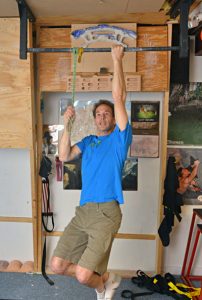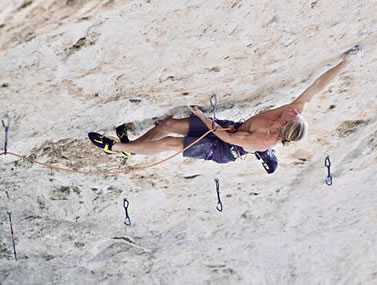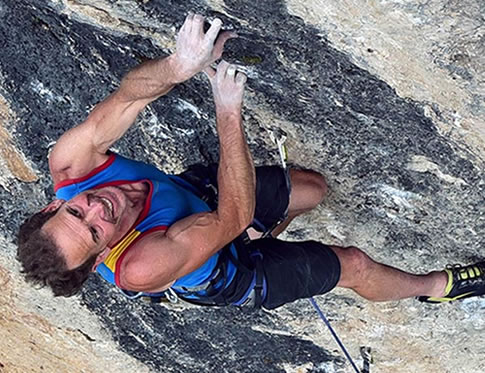Change up your pull-up game to break through upper-body strength barriers. Try these four variations on the classic pull-up.
(This article was originally published in February of 2018).
Although your fingers and toes are your primary link to the rock, it’s the larger muscles of your arms, legs, and torso that facilitate most of the upward movement in climbing. Of course, lack of leg strength is rarely, if ever, a limiting constraint on the rock—it’s the large pull muscles of the upper body that are most likely to fail you. Therefore, developing more upper-body strength, power, and endurance must be central to every training-for-climbing program.
While simply climbing a few days per week will build a moderate level of pulling strength and endurance, use of more target training techniques will provide beneficial gains so that the pulling muscles will never limit you on the rock. Toward this end, let’s examine four variations on the common Pull-Up to spice up your workouts—the first two exercises develop pull-muscle strength, while the last two train strength-endurance.
#1: Weighted Pull-Ups
Adding weight to your body while performing certain climbing-specific exercises (a technique called hypergravity training) is a highly effective way to develop strength in the pull muscles. Weighted Pull-Ups are the simplest way to get started. However, keep in mind that only experienced climbers who can do at least 15 pull-ups at bodyweight and have no history of shoulder or elbow injuries should start strapping on extra weight.
Wearing a ten- or twenty-pound weight belt while doing your pull-up training will trigger the neuromuscular system to adapt to a higher apparent body weight. When you remove the weight, you will feel noticeably lighter and climb stronger. Perform two to four sets of weighted pull-ups toward the end of your climbing session, up to two days per week.
A few notes on form: First, do not hang in the straight-armed position to rest between repetitions. This is extremely stressful on the shoulders. Second, reduce the weight—or remove it entirely—if you experience any unusual pain in your shoulders or elbow.

Uneven-Grip Chin-Up
#2L Uneven-Grip Pull-Ups
This is an excellent exercise for developing high-end strength, as well as the ability to lock-off on one arm. You’ll need to offset one hand 18 to 24 inches lower than the other. The easiest way to do this is by looping a sling over a pull-up bar. Begin with your hands offset vertically in this way, gripping with your upper palm either facing you (chin-up style, which is a bit easier) or palm facing away (harder). Pull with a focus on putting most of your weight into the higher hand. As you reach the height of the lower hand, start pushing downward on that side. Continue to pull up with the high hand until it is drawn in tight against the front of your shoulder. Lower yourself to the starting position to a two-second count, then immediately begin the next repetition.
Repeat until you can no longer pull up the whole way with your high hand. Rest for a minute or two, and then switch hands to train the opposite side. Perform two or three sets on each side with the goal of three to six repetitions per set. Increase the vertical distance between your hands if you can do more than six reps; decrease the distance if you cannot complete at least three.
#3: Pull-Up Intervals
Whereas the three previous exercises build strength, the following two train endurance. Your goal is to complete twenty, one-minute pull-up intervals comprised of a set number of pull-ups and a rest period. Use a timer so that you can stick to an exact schedule.
Start the clock and immediately perform five pull-ups. Strive for a smooth, steady pace that takes about two seconds for each complete repetition. After the five pull-ups, dismount and rest for the remainder of the one-minute interval. At the one-minute mark, begin your next set of five pull-ups. Upon completion of the fifth pull-up, dismount and rest again for the remainder of the minute interval.
At this point, you might be thinking that this doesn’t feel like much of a workout…but just wait a few more minutes! Continue with this pattern for a total of ten to twenty minutes. If you make it to ten minutes, you’ll have completed fifty pull-ups total—a pretty good endurance workout. If you make it the full twenty minutes, congratulate yourself for doing one hundred pull-ups! If you tap out before the ten-minute mark, reduce the number of pull-ups per set to just three or four. Conversely, if you find that the full twenty-minute routine feels less than grueling, increase the number of pull-ups per set to six, seven, or more.
#4: Frenchies
It’s been more than 20 years since I first coined the name “Frenchies” in my first book, Flash Training. This unique exercise adds isometric contractions to the pull-up movement, making this perhaps the best pull-muscle endurance exercise for climbers. They’re inherently uncomfortable due to the acidosis that develops in the large muscles of your back and arms. But you’ll reap the benefits in terms of both better lock-off endurance on the rock and a marked increase in pull-up ability.
Grip a pull-up bar or the bucket holds off a fingerboard with palms facing out. Pull up to the top position and lock off with your hands against your chest for a four-second count. Lower yourself to a straight-armed position, and then pull up to the top position again. This time, lower yourself only halfway and lock-off at a 90-degree angle (as shown in the photo here). Hold this position statically for a slow, four-second count, then lower yourself to the bottom. Pull up a third time, and lower yourself a little further—about two-thirds of the way with an elbow angle of 120 degrees. Hold here for another static, four-second lock-off. Lower to the bottom position and you will have completed one full cycle.
But don’t stop here! Without hanging on straight arms to rest, immediately begin a second cycle of Frenchies: pulling up three more times with four-second lock-offs in each of the three positions. Be sure to hold all the lock-offs for a full four-second count, despite the burning that begins to develop. Continue through a third, fourth, and fifth rep cycle, if you’re able. Stop when you can no longer perform a full pull-up or hold the lock-off. Rest for five minutes, then attempt a second and third set. You’ll soon discover that this exercise gets hard fast. Add in this exercise up to two days per week to reach a whole new level of muscular endurance!
Related Articles:
- Power Training with the Chest-Bump Pull-Up
- The Best Climbing Exercise You’re Not Doing: The Scapular Pull-Up!
- Develop One-Arm and Lock-Off Strength with Uneven-Grip Pull-Ups
- “5×5” Pull-Up Training for Increased Strength, Power, and Endurance
- Intro to Hangboard Training
Copyright 2018-2023 Eric J. Hörst. All rights reserved.









![🚨New Training For Climbing podcast drop! [**Link in bio.**]
This a two-part deep dive into designing a comprehensive, long-term systems approach to training. Coach @eric_horst unpacks—in rich detail—how systems actually function, and he highlights how transformative climbers throughout history “shake up the box” with innovative, highly effective methods to achieve big goals and push the boundaries of our sport.
In Part 1 (#122), Eric blends a concise climbing history lesson with an engineer-like breakdown of how intelligent systems operate. Part 2 (#123) of this series will deliver the actionable strategies you can use to build a personalized, high-performance training system for this winter…and for many seasons to come.
Eric emphasizes that as climbers progress beyond the beginner stage, climbing and training grow increasingly complex—requiring intentional, organized, and year-round development of strength, technique, mental skills, recovery habits, nutrition, and lifestyle management. Rather than ad-lib sessions or singular-focus programs (like only training strength), climbers need a comprehensive system fine-tuned daily and seasonally.
This is an entertaining and thought-provoking episode—so lean in, listen closely, and get ready to feel inspired, challenged, and equipped to level-up your modus operandi at the crag, in the gym, at home, and in everything you do! Listen on Apple Podcasts, Spotify, or online using the web player below.
#climbingtraining #bouldering #indoorclimbing #climbing #climbingpodcast #erichorst #trainingforclimbing @lasportivana @physivantage](https://trainingforclimbing.com/wp-content/plugins/instagram-feed/img/placeholder.png)


